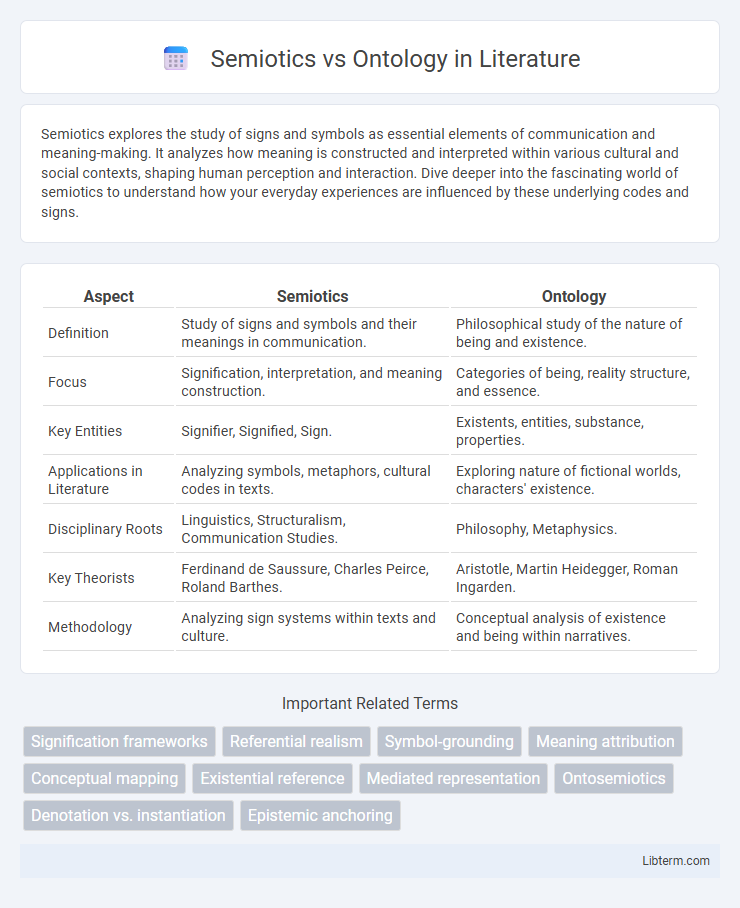Semiotics explores the study of signs and symbols as essential elements of communication and meaning-making. It analyzes how meaning is constructed and interpreted within various cultural and social contexts, shaping human perception and interaction. Dive deeper into the fascinating world of semiotics to understand how your everyday experiences are influenced by these underlying codes and signs.
Table of Comparison
| Aspect | Semiotics | Ontology |
|---|---|---|
| Definition | Study of signs and symbols and their meanings in communication. | Philosophical study of the nature of being and existence. |
| Focus | Signification, interpretation, and meaning construction. | Categories of being, reality structure, and essence. |
| Key Entities | Signifier, Signified, Sign. | Existents, entities, substance, properties. |
| Applications in Literature | Analyzing symbols, metaphors, cultural codes in texts. | Exploring nature of fictional worlds, characters' existence. |
| Disciplinary Roots | Linguistics, Structuralism, Communication Studies. | Philosophy, Metaphysics. |
| Key Theorists | Ferdinand de Saussure, Charles Peirce, Roland Barthes. | Aristotle, Martin Heidegger, Roman Ingarden. |
| Methodology | Analyzing sign systems within texts and culture. | Conceptual analysis of existence and being within narratives. |
Understanding Semiotics: The Study of Signs
Semiotics is the study of signs and symbols as elements of communicative behavior, focusing on how meaning is created and interpreted through sign processes. It analyzes the relationship between the signifier (form of the sign), the signified (concept), and their referents, contrasting with ontology's concern with the nature of being and existence. Understanding semiotics involves exploring sign systems in language, media, and culture to decode how meaning shapes human perception and social reality.
Defining Ontology: The Nature of Being
Ontology explores the fundamental nature of being, existence, and reality, defining categories and relationships that constitute entities within a domain. It establishes a structured framework to represent knowledge about what exists, differentiating between objects, properties, and their interrelations. In contrast to semiotics, which interprets signs and meaning, ontology rigorously categorizes the essence and existence of things in both philosophical and computational contexts.
Historical Roots of Semiotics and Ontology
Semiotics, with origins traced back to Charles Sanders Peirce and Ferdinand de Saussure in the late 19th and early 20th centuries, examines the relationship between signs, symbols, and meaning in human communication. Ontology, rooted in ancient Greek philosophy through thinkers like Aristotle, systematically studies the nature of being, existence, and reality. The historical development of semiotics centers on language and sign systems, whereas ontology's foundation lies in metaphysical inquiry about what entities fundamentally exist.
Key Theorists in Semiotics and Ontology
Semiotics, primarily shaped by Ferdinand de Saussure and Charles Sanders Peirce, explores the structure and interpretation of signs and symbols within communication systems. Ontology, rooted in the philosophy of Aristotle and further developed by Martin Heidegger, investigates the nature of being and existence. Contemporary discourse often contrasts Peirce's triadic model of signs with Heidegger's existential analysis to differentiate between meaning-making processes and the fundamental categories of reality.
Methodological Differences: Semiotics vs Ontology
Semiotics analyzes meaning through signs, symbols, and their interpretations within cultural contexts, employing a qualitative, interpretative methodology focused on communication processes. Ontology investigates the nature of being and existence, using a more abstract, philosophical methodology aimed at defining categories and relationships of reality. The methodological difference lies in semiotics' emphasis on sign systems and meaning-making, while ontology prioritizes the structural and foundational aspects of existence.
How Semiotics Shapes Meaning
Semiotics shapes meaning by analyzing the relationship between signs, symbols, and their interpretation within cultural contexts. It decodes how meaning is constructed through signifiers and signified concepts, emphasizing the fluidity and multiplicity of interpretations. This dynamic process contrasts with ontology's focus on the nature of being and existence, highlighting semiotics' role in understanding communication and meaning-making.
Ontology's Role in Defining Reality
Ontology plays a crucial role in defining reality by establishing the fundamental categories and relationships that constitute existence. It provides a structured framework to understand what entities exist and how they interact within a given domain, enabling precise modeling of complex systems. Unlike semiotics, which focuses on signs and meaning-making processes, ontology centers on the nature of being and the organization of reality itself.
Points of Convergence and Divergence
Semiotics and ontology converge in their exploration of meaning, where semiotics analyzes signs and symbols as fundamental units of communication, and ontology investigates the nature of being and existence. Divergence arises as semiotics focuses on the interpretive processes and sign systems shaping human understanding, while ontology concerns itself with categorizing and defining the entities that constitute reality independently of perception. Both disciplines intersect in metaphysical inquiries but diverge in methodology--semiotics employs linguistic and cultural frameworks, whereas ontology relies on philosophical and logical structures.
Semiotics and Ontology in Contemporary Philosophy
Semiotics in contemporary philosophy analyzes the structures of signs and symbols as fundamental to meaning-making processes, emphasizing the interpretive frameworks through which knowledge and reality are constructed. Ontology, conversely, investigates the nature of being and existence, addressing questions about what entities fundamentally constitute reality independent of interpretation. The interplay between semiotics and ontology reveals how philosophical inquiries into existence incorporate the mediation of signs, shaping our understanding of what is real through language and representation.
Applications and Implications in Modern Disciplines
Semiotics analyzes signs and symbols as fundamental elements of communication, playing a crucial role in fields like linguistics, marketing, and cultural studies by decoding meaning-making processes. Ontology, concerned with the nature of being and existence, underpins computer science, information systems, and philosophy by structuring data and knowledge representation frameworks. Together, these disciplines inform artificial intelligence development, enhancing semantic web technologies and improving human-computer interaction through nuanced understanding of both meaning and entity relationships.
Semiotics Infographic

 libterm.com
libterm.com